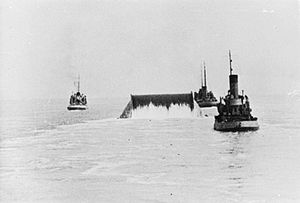
Back عملية بلوتو Arabic Operation Pluto Danish Operation PLUTO German Operación PLUTO Spanish عملیات پلوتو Persian Operaatio Pluto Finnish Opération PLUTO French מבצע פלוטו HE Operasi Pluto ID Operazione Pluto Italian

Operation Pluto (Pipeline Under the Ocean or Pipeline Underwater Transportation of Oil, also written Operation PLUTO) was an operation by British engineers, oil companies and the British Armed Forces to build submarine oil pipelines under the English Channel to support Operation Overlord, the Allied invasion of Normandy during the Second World War.
The British War Office estimated that petrol, oil, and lubricants would account for more than 60 per cent of the weight of supplies required by the expeditionary forces. Pipelines would reduce the need for coastal tankers, which could be hindered by bad weather, were subject to air attack, and needed to be offloaded into vulnerable storage tanks ashore. A new kind of pipeline was required that could be rapidly deployed. Two types were developed, named "Hais" and "Hamel" after their inventors. Two pipeline systems were laid, each connected by camouflaged pumping stations to the Avonmouth-Thames pipeline.
The first was the not-very-successful "Bambi" project, which connected Sandown on the Isle of Wight to Cherbourg in Normandy. Deployment of Bambi began on 12 August 1944, and it delivered just 3,300 long tons (3,400 t) between 22 September, when the first pipeline became operational, and 4 October, when it was terminated. More successful was "Dumbo", which ran from Dungeness on the Kent coast to Boulogne in Pas-de-Calais. The Dumbo system began pumping on 26 October, expanded to 17 pipelines by December, and remained in action until 7 August 1945. Ultimately, the pipelines carried about 8 per cent of all petroleum products sent from the United Kingdom to the Allied Expeditionary Force in North West Europe, including some 180 million imperial gallons (820 million litres) of petrol.
© MMXXIII Rich X Search. We shall prevail. All rights reserved. Rich X Search